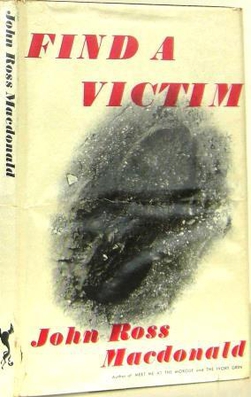
The Saint Valentine's Day Massacre was the murder of seven members and associates of Chicago's North Side Gang that occurred on Saint Valentine's Day 1929. The men were gathered at a Lincoln Park, Chicago garage on the morning of February 14, 1929. They were lined up against a wall and shot by four unknown assailants, two dressed as police officers. The incident resulted from the struggle to control organized crime in the city during Prohibition between the Irish North Siders, headed by George "Bugs" Moran, and their Italian Chicago Outfit rivals led by Al Capone. The perpetrators have never been conclusively identified, but former members of the Egan's Rats gang working for Capone are suspected of a role, as are members of the Chicago Police Department who allegedly wanted revenge for the killing of a police officer's son.

Ross Macdonald was the main pseudonym that was used by the American-Canadian writer of crime fiction Kenneth Millar. He is best known for his series of hardboiled novels set in Southern California and featuring private detective Lew Archer. Since the 1970s, Macdonald's works have received attention in academic circles for their psychological depth, sense of place, use of language, sophisticated imagery and integration of philosophy into genre fiction.

Junko Furuta was a Japanese high school student who was abducted, raped, tortured and murdered in the late 1980s. Her murder case was called the "concrete-encased high school girl murder case" (女子高生コンクリート詰め殺人事件), due to her body being discovered in a concrete drum. The abuse was mainly perpetrated by four teenage boys, Hiroshi Miyano, Jō Ogura, Shinji Minato, and Yasushi Watanabe, over a period of 40 days from November 1988 to January 1989.
Lew Archer is a fictional character created by American-Canadian writer Ross Macdonald. Archer is a private detective working in Southern California. Between the late 1940s and the early '70s, the character appeared in 18 novels and a handful of shorter works as well as several film and television adaptations. Macdonald's Archer novels have been praised for building on the foundations of hardboiled fiction by introducing more literary themes and psychological depth to the genre. Critic John Leonard declared that Macdonald had surpassed the limits of crime fiction to become "a major American novelist" while author Eudora Welty was a fan of the series and carried on a lengthy correspondence with Macdonald. The editors of Thrilling Detective wrote: "The greatest P.I. series ever written? Probably."

The Moving Target is a detective novel by writer Ross Macdonald, first published by Alfred A. Knopf in April 1949.

Blue City is a thriller written in 1947 by Ross Macdonald. The novel was originally released under his real name, Kenneth Millar, by Alfred A. Knopf, while a condensed version was serialized in the August and September 1950 issues of Esquire.
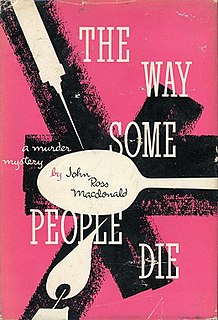
The Way Some People Die is a detective mystery published, under the author's then pseudonym of John Ross Macdonald, by Alfred A. Knopf in 1951. It is Ross Macdonald's third book to feature his private eye Lew Archer. The plot centres on the activities of heroin-traffickers, a form of criminality which Macdonald particularly despised.
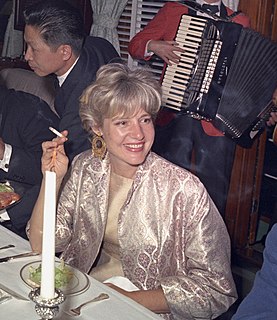
Mary Eno Pinchot Meyer was an American painter who lived in Washington D.C. She was married to Central Intelligence Agency official Cord Meyer from 1945–1958, and became involved romantically with President John F. Kennedy after her divorce from Meyer.
The Bugs (Bugsy) and Meyer Mob was a Jewish-American street gang in Manhattan, New York City's Lower East Side. It was formed and headed by mobsters Bugsy Siegel and Meyer Lansky during their teenage years shortly after the start of Prohibition. The Bugs and Meyer mob acted as a predecessor to Murder, Inc.

Harper is a 1966 American mystery film based on Ross Macdonald's 1949 novel The Moving Target and adapted for the screen by novelist William Goldman, who admired MacDonald's writings. The film stars Paul Newman as Lew Harper, and was directed by Jack Smight, with a cast that includes Robert Wagner, Julie Harris, Janet Leigh, Shelley Winters, Lauren Bacall, and Arthur Hill.

The Galton Case is the eighth novel in the Lew Archer series by Ross Macdonald. It was published in the US in 1959 by Knopf and in 1960 by Cassel & Co in the UK. The book has been widely translated, although the title has been changed in some cases to highlight other aspects of the story. In French it appeared as Un Mortel Air De Famille ; in Turkish as Ölmek Yasak ; in Finnish as Rouva Galtonin perillinen ; and in Italian as Il ragazzo senza storia. Macdonald thought that with this novel he found his own voice as a writer.
The Forty-Two Gang is a teenage street gang in Chicago that started during Prohibition. Like Brooklyn's Italian and Jewish street gangs of Brownsville and Ocean Hill, the Forty-Two Gang serves as a "farm team" for future members of the Chicago Outfit. Forty-Two Gang members include future syndicate members Sam "Teets" Battaglia, Luigi "Cockeyed Louie" Fratto, Felix "Milwaukee Phil" Alderisio, "Mad Sam" DeStefano, Charles "Chuckie" Nicoletti, Fiore "Fifi" Buccieri, William "Smokes" Aloisio, Frank "Skids" Caruso, William "Willie Potatoes" Daddano, Joseph DiVarco, Marcello Caifano, Mario DeStefano, Bruno Tassione, and Joey "Cowboy" Miletta.
The Philadelphia poison ring was a murder for hire gang led by Italian immigrant cousins, Herman and Paul Petrillo, in 1930s Philadelphia, US where the Italian community had grown from 76,734 in 1910 to over 155,000 by 1930 - just before the murder ring began operations. The ring came to light in 1938 and the cousins were ultimately convicted of first degree murder(s) and executed by electric chair in 1941.
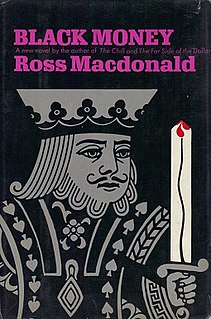
Black Money is a novel by US American mystery writer Ross Macdonald. Published in 1966, it is among the most powerful of all Ross Macdonald's novels and was his own personal choice as his best book.
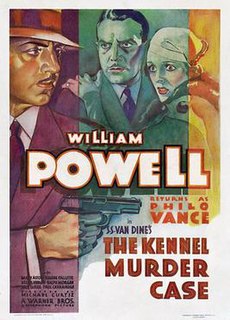
The Kennel Murder Case is a 1933 American pre-Code mystery film adapted from the 1933 novel of the same name by S. S. Van Dine. Directed by Michael Curtiz for Warner Bros., it stars William Powell and Mary Astor. Powell's role as Philo Vance is not the actor's first performance as the aristocratic sleuth; he also portrays the character in three films produced by Paramount in 1929 and 1930.
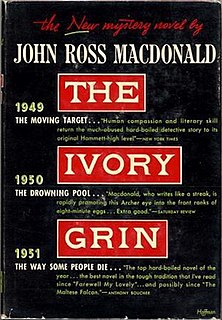
The Ivory Grin is Ross Macdonald's fourth Lew Archer detective novel, published in April 1952. Like most of Macdonald's, the plot is complicated and takes place mostly in out of the way Californian locations.

The Barbarous Coast was Ross Macdonald’s sixth Lew Archer novel. It was published by Alfred A. Knopf in 1956, and by Bantam Books as a paperback. It takes an acid view of South Californian society that foreshadows Macdonald's later treatment of cross-generational deterministic themes.

The Name Is Archer is a collection of short stories written by Ross Macdonald and featuring his detective hero, Lew Archer. Originally compiled in 1955 and published under the name John Ross Macdonald, more stories were added in later collections under different titles.

Meet Me at the Morgue is the ninth novel completed by Ross Macdonald. Credited at the time to John Ross Macdonald, it was published in 1953 by A. A. Knopf and released as a paperback by Pocket Books the following year. In that year too the book was published by Cassell & Co in the UK under the title Experience with Evil. There had been disagreement over the novel's original title. Knopf turned down Macdonald's suggestion of Message from Hell and Macdonald turned down the suggestion of The Convenient Corpse from Pocket Books.

The Chill is Ross Macdonald's eleventh Lew Archer novel, published by Alfred A. Knopf in their Borzoi series in 1964. Macdonald's reputation was now growing and the front cover bore the announcement "a new novel by the author of The Zebra Striped Hearse", which had been well received. After the book was published by Collins Publishers in the UK that year, it went on to gain the Silver Dagger award for 1964 from the British Crime Writers Association. A French translation also appeared in 1964, followed by a Danish translation the following year and an Italian translation in 1967.
